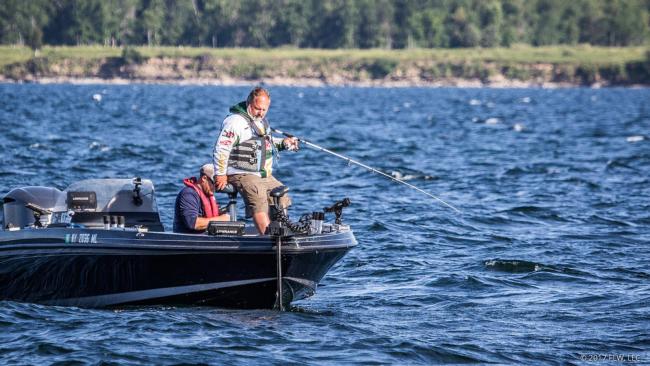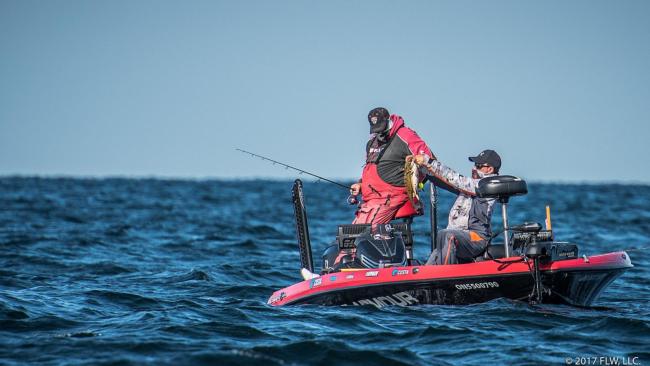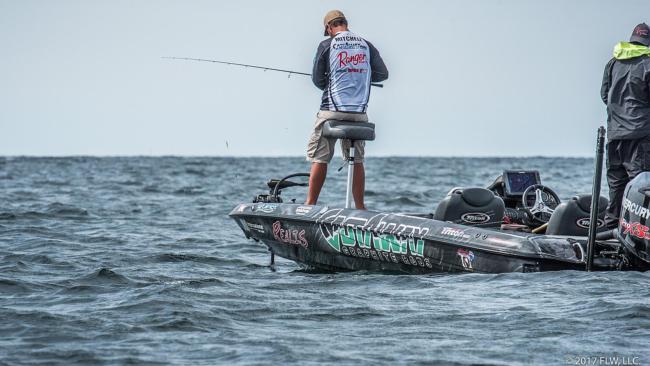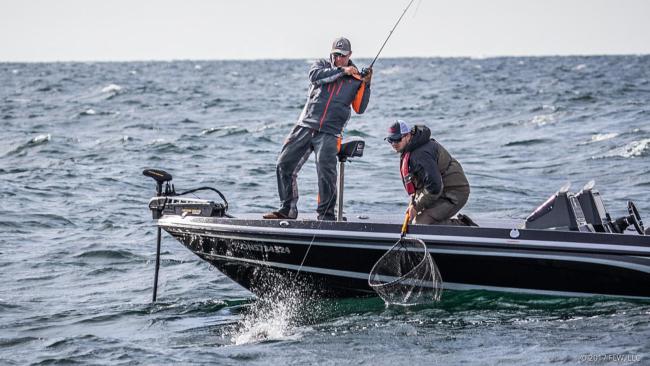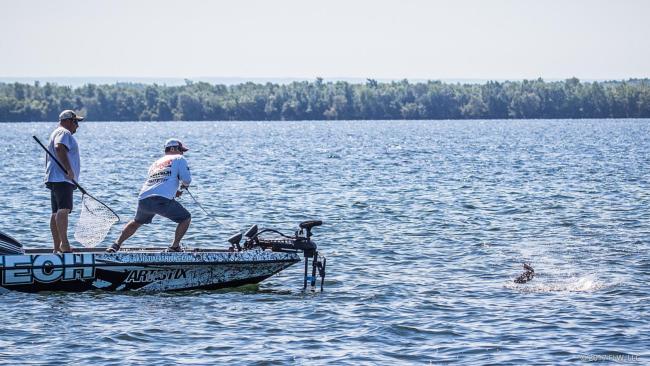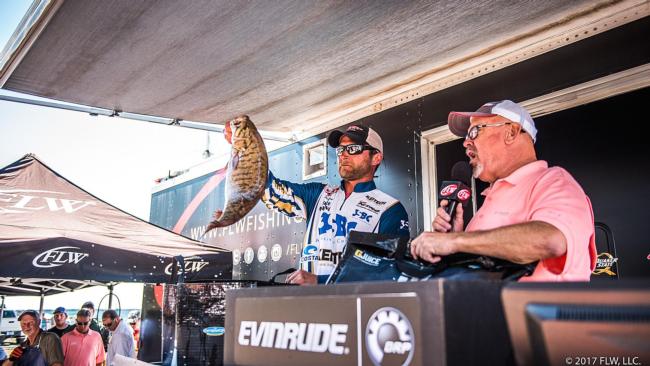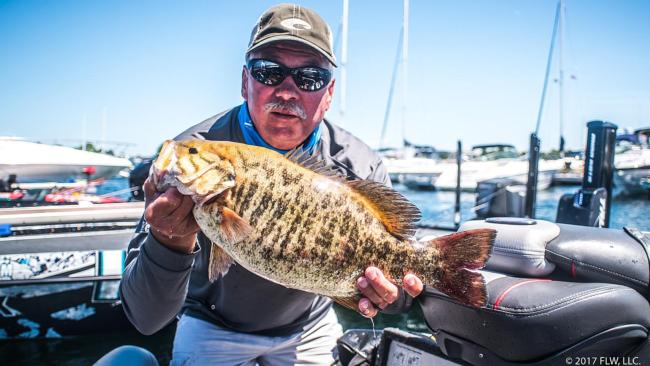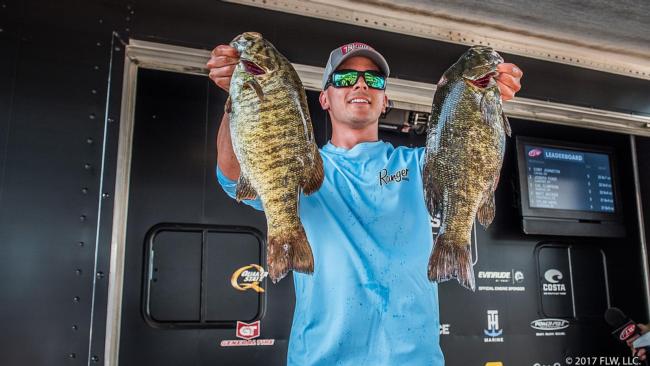Top 10 Patterns from the 1000 Islands
Only one pro stayed in the river
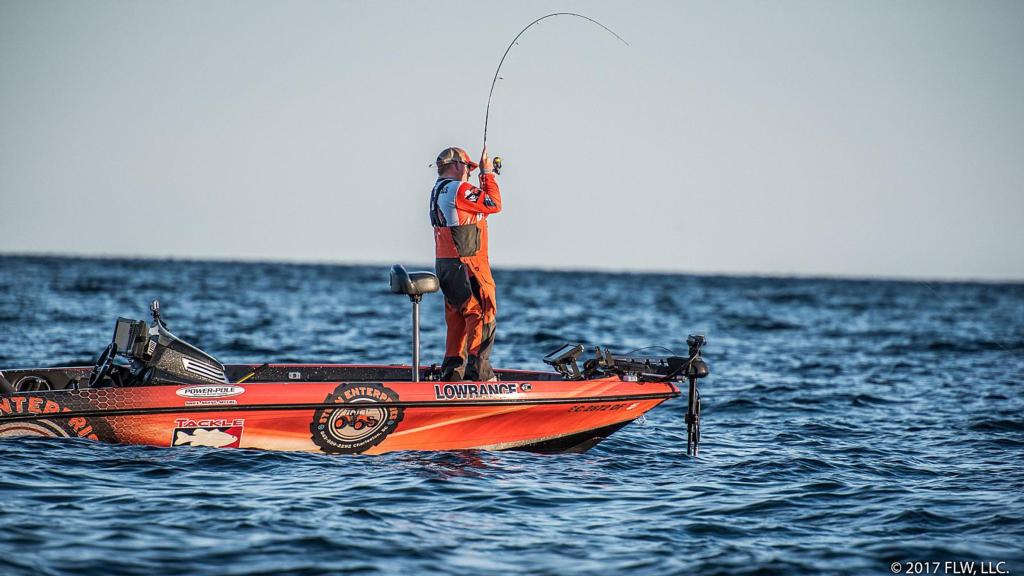
The 1000 Islands region sits at the transition between Lake Ontario, which is the easternmost Great Lake, and the St. Lawrence River. Both places have a history of producing mega-bags of smallmouths. For this year’s Costa FLW Series showdown at the 1000 Islands, it was Lake Ontario that did the heavy lifting. With big smallmouths setting up offshore for the summer, the top 10 pros flocked to the lake. Out in Ontario, Matt Becker earned the win, and literally everyone in the top 10 besides Ed Casey spent at least two days of competition on the lake.
2. Steady almost does it for Fonzi
Huge bags of smallmouths defined the tournament, but Joseph Fonzi never stuck a mid-20s bag. Instead, he plugged away with 22 pounds and change on days one and two and just less than 21 pounds on the final day. Fonzi was one of three pros in the top 10 who never weighed a bag in the teens, but he never managed a highlight day.
Fonzi spent his tournament out in Ontario around Galloo and the other nearby islands, and primarily targeted steep breaks where the fish set up on or near the drop in 30 or more feet of water.
Fonzi guides on Lake Erie and is an expert on offshore smallmouths, but after securing the lead on day two, he fell off slightly on the final day.
“Something changed,” says Fonzi of his final day. “It wasn’t as rough, and my fish were moving in and out on structure. The stronger the wind is, I think it actually pushes bait in there, and I didn’t have enough wind to push my fish into my area.”
Fonzi did a little dragging on the final day, but on days one and two he almost exclusively dropped down on fish he marked on his Lowrance. His weapon of choice was a drop-shot, and he was usually feeding the fish either a small morsel of Gulp! or a Yamamoto Shad Shape Worm.
3. One bad day dooms Chris Johnston
Over the final two days, nobody caught them better than Chris Johnston. On day two, the FLW Tour pro smashed 26-7, the biggest bag of the tournament, and he followed it up with 23 pounds on the final day. Unfortunately, he was trying to come back from 40th place and only 16-2 on day one – a task that ultimately proved impossible.
Johnston’s first day was a disaster. After riding for more than two hours in the roughest water of the week, the Canadian hammer arrived at his spot to find the water dirty and the fish gone. On day two, he went to an area near Galloo Island that he deemed more steady, and it was all up from there.
He started the final day where he left off on Friday – a place where he’d left them biting.
“For the first two hours I got quite a few bites, but it wasn’t quite the same quality,” he says. “I was going through a lot more 2- and 3-pounders with the odd good one mixed in. About 9:30 it shut down, they got more scattered and when you marked them they didn’t want to eat. So, I went running and did another lap around the lake.”
Though Johnston admits that he caught one fish shallow in the afternoon on day three, the bulk of his weight came drop-shotting a Jackall Crosstail Shad in 30 to 40 feet of water. He reckons that he marked about 80 percent of the fish he caught before dropping his bait down to them. Like most everyone else who did well, he spent almost all his time in Ontario.
“I came into the river for a half-hour today [Saturday] at the end of the day because I had some time and didn’t get a bite,” says Johnston. “That’s why I stayed in the lake.”
With a total of 495 points and two top-10 finishes, Johnston now leads the Northern Division Angler of the Year race.
4. Mitchell sticks to the lake
Kurt Mitchell practiced with co-angler winner Gary Haraguchi, and the pair certainly had a profitable week at the 1000 Islands. Like the rest, Mitchell ran out to Ontario each day and fished vertically for smallmouths almost the entire time.
On day one he did his damage at Grenadier Island, but that failed him on day two and forced a location change. On the final two days, he spent his time at Stony Island and Galloo. Mitchell says he mostly fished about 30 feet deep, but was in the 20-foot range on the final day when he caught his fish.
Unlike the top three, Mitchell was comparatively lacking in Great Lakes experience, with only a 26th-place finish in the 2015 Costa FLW Series event on Erie to his credit.
“When I was on Erie I fished one point the entire tournament,” says Mitchell. “It was a community hole, and I just sat there the entire tournament. I didn’t learn much, but I got a check. One thing I learned about this place is you can’t just sit still if you’re not catching them. If they’re there, they’re eating. You just have to keep on running around until you find them.”
When he did find them, the FLW Tour sophomore drop-shotted a shad-colored Yamamoto Shad Shape Worm most of the time and caught a few casting a grass minnow-colored Duo Realis G-Fix Spinbait 80.
5. Thompkins ditches practice plan for the lake
Making the trek up from South Carolina, Timmy Thompkins broke the 20-pound mark each day, despite only fishing for two hours on day one due to seasickness.
Thompkins spent almost all of his practice in the St. Lawrence River, but decided to head to the lake on the last day.
“I found the fish on Wednesday, and I got dialed in,” says Thompkins. “Then I just scanned for several hours and I ran out of time. If I could have turned back the clock and got some more time behind the Lowrance, I’m not gonna say I would have caught more fish, but I would have had some more places to fish.”
Thompkins ended up concentrating on five key stretches of rock and irregular bottom around Galloo. He says he caught fish from 25 to 40 feet of water, but figures that the range from about 28 to 35 feet was the best. His drop-shot was a little different from the rest, as he used a heavier-than-usual 3/4-ounce weight and tipped it with a Strike King Dream Shot.
“The only reason I fished the Northern trail was because I don’t know smallmouth fishing at all,” says Thompkins. “It’s a weakness. I came up to Champlain, and I finally started to figure it out the last day of the tournament. So, I really learned a lot there, and I learned a ton here.”
6. Team Johnston keeps rolling
Chris and Cory Johnston finished second and fourth in last year’s event at the 1000 Islands. This year the flagbearers for Team Canada took a step back and finished third and sixth, respectively.
Cory led after day one with a monster bag plucked from the river and the lake, but he caught his fish the rest of the tournament far out in Lake Ontario.
“I caught one fish shallow today [Saturday]. The rest all came off one deep spot,” says Cory of his day three. “I hadn’t weighed a fish there yet in the tournament. I wasn’t even going to go there, but it was loaded. Once I caught what I had I couldn’t catch anymore. They just scattered.”
Though the elder Johnston brother mixed things up a little simply due to his massive amount of history on the fishery, he by and large stuck to fishing deep in the lake. He says he caught a few on a tube, but landed most of his fish with a drop-shot with a Jackall Crosstail Shad.
“I’m really disappointed in yesterday,” says Cory of day two, when he weighed only 17-3. “I had the bites to have 22 pounds yesterday, and I lost them, I broke them off and I missed them. It was one of those days that nothing goes right for you.”
7. Smith mixes it up
If variety is the spice of life, then Casey Smith was by far the spiciest angler in the top 10 at the 1000 Islands. Smith ran into Lake Ontario every day, but he didn’t just fish deep.
“I started deep,” says Smith. “I didn’t have big schools; I just had small, isolated groups. I kinda burned through them on day one. On day two they moved around with the wind shift. They had scattered so bad I bailed on that pretty early, and I ran down to Chaumont and started fishing history.”
In the lake Smith tossed a drop-shot in 30-plus feet like the rest, but in Chaumont Bay he targeted rock ridges and humps with scattered grass in 15 to 20 feet of water. He fished Chaumont in a remarkably similar way to how he fished on Oneida last year, casting either a 3.3-inch perch-colored Keitech Swing Impact FAT swimbait or an umbrella rig with 3.8-inch Swing Impact FATs and 4-inch Keitech Swing Impacts.
8. Umbrella rig plays for O’Brien as well
Hailing from Rochester, N.Y., Chris O’Brien fished very similarly to Smith, and by and large spent his time shallower than the first- through sixth-place finishers.
“I caught my fish anywhere from 8 to 30 feet,” says O’Brien. “I was throwing an A-rig the majority of the time, but I would offset it with a drop-shot. I was targeting staging fish that were late spawners before they moved out to their deep summer haunts.”
O’Brien says he fished in Chaumont Bay some, but also spent time in the rest of the southeast corner of Ontario.
“I gave the river a chance, but I couldn’t get it going,” says O’Brien. “I’ve spent 30 years up here – my family has a cottage – but I couldn’t get it fired up.”
On the first day with a west wind, O’Brien says he caught everything that bit. On the second and third days, he had a lot of trouble hooking and landing his fish, and they would often hit his umbrella rig three or four times on the way back in.
9. Casey wins the river tournament
Ed Casey has the distinction of being the only member of the top 10 to spend all his time in the St. Lawrence River. Casey weighed right around 20 pounds each of the first two days, but only managed four keepers on the final day.
In the river, he mostly fished four shelves for smallmouths where he had marked fish in practice. Keeping his boat in 30 to 40 feet of water, he would toss his bait up into about 10 feet of water and drag it off the break. He did most of his damage with a custom-made “winky bait” in a smoke/purple/watermelon color on a drop-shot.
Casey also fished for largemouths a little, and weighed in a 4-pound green one each of the last two days. For that, he turned to the good ol’ wacky-rigged Yamamoto Senko.
10. Climpson’s pattern deteriorates
Making the top 10 at the 1000 Islands for the second year in a row, Cal Climpson smoked them on day one, plucking 22-6 from Lake Ontario. From there, things went downhill, culminating in what he calls his “worst day ever” at the 1000 Islands.
“Earlier in the week was good, but my pattern deteriorated as the week went on,” says Climpson. “I had one deep spot out in the lake, but the northeast wind changed all that. I only had one deep spot for backup, and they weren’t on that.”
Scrambling on day two, Climpson caught his limit partly in the lake and partly in the river. He spent all of the final day in the river.
“Today [Saturday] I went for the mega-bag,” says the Canadian angler. “For me the mega-bag is in shallow, so I fished shallow all day. I knew it wasn’t happening. Normally about 1 o’clock is when it starts to get good, and it didn’t. It can happen out here in 10 minutes. You can roll up to a spot and catch five 5s [5-pounders] that you see in 10 minutes, but it didn’t happen.”
Climpson caught all his weight on a drop-shot with a Jackall Crosstail Shad, using it deep in the main lake and casting it to sighted fish shallow in the river.
